
Аракин 1 курс
.pdf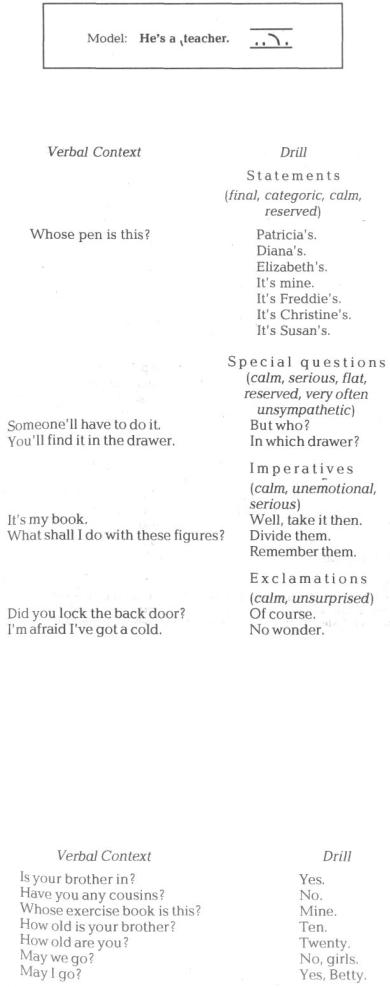
3. a)* Listen carefully to the following conversational situations. Concentrate your attention on the intonation of the replies:
b) Listen to the replies and repeat them in the intervals. Make your voice fall as low as possible. Do not forget to blend the words together. c) Listen to the verbal context and reply in the interval.
4.In order to fix Intonation Pattern I in your mind, ear and speech habits repeat all the replies yourself until they sound perfectly natural to you. See that your Russian pronunciation habits do not interfere.
5.Listen to a fellow-student reading the replies. Tell him what his errors in intonation are.
6.Listen to your teacher reading the verbal context below. Reply by using one of the drill sentences. Pronounce it with Intonation Pattern I. Say what attitude you mean to render:
201
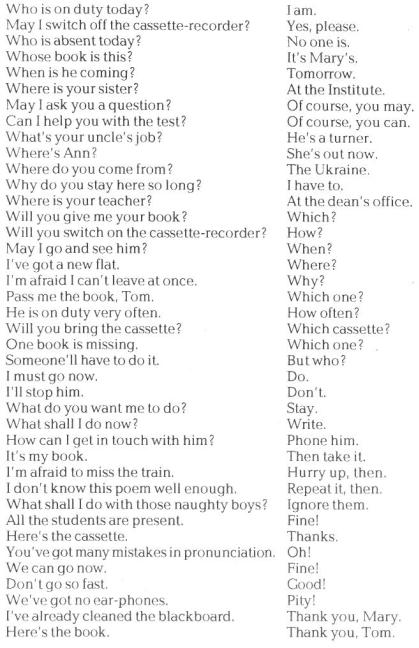
7.Your teacher will suggest a verbal content. You in turn respond by using: a) statements, sounding final, categoric, calm, reserved; b) special questions, sounding calm, serious, flat, reserved or unsympathetic; c) imperatives, sounding calm, unemotional, serious; d) exclamations, sounding calm, unsurprised, reserved.
8.Read the following rhythmic groups. Observe quick pronunciation of unstressed syllables:
a)Write to her. Read to me. Wait for them. Talk to her. Mary can. Answer it. Certainly. Open it. Tell them that. Nobody is.
b)I can answer you. I can wait for you. It was wonderful. It's impossible. You must tell them that. He can write to you. I can give it to him. They must keep it for you. You could do it for me.
Section Two
Intonation Pattern II
(Low pre-head +) descending head+ low fall (+ tail)
202
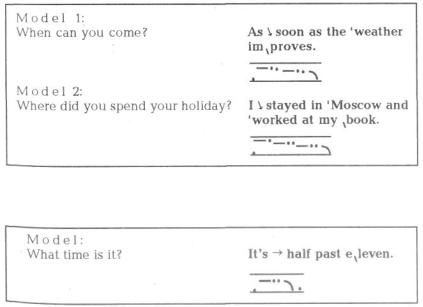
(Low pre-head) + high level head + low fall (+ tail)
Stress-and-tone marks in the text:
Stressed syllables of the descending head:
the first stressed syllable [ ]
any following stressed syllables of the head [ ' ]
The first stressed syllable of the descending head is pronounced on the high level pitch. Sometimes it is pronounced with a slight rise. The following stressed syllables have level pitch and form a descending sequence until the nucleus is reached, unstressed syllables may either carry the pitch down as in Model 1 (the Falling Head) or they may he pronounced on the level of the preceding stressed syllable as in Model 2 (the Stepping Head). The Low Fall in the nucleus starts somewhat lower than the mid level. If there are any unstressed syllables before the first stressed syllable they are said on a rather low pitch.
This intonation pattern is used:
1. I n s t a t e m e n t s , final, categoric, considered.
e. g. How much did you pay for it?
What is the weather like?
It costs over 'two 'hundred pounds.
I think it is 'going to \rain.
2. I n s p e c i a l q u e s t i o n s , |
serious, responsible, intense, often suggesting irritability or impatience. |
e. g. Will you lend me your |
What do you \want it for? |
pen? |
What 'place does he \live in? |
Go and see him tomorrow. |
|
3. I n i m p e r a t i v e s , firm, serious, pressing. |
|
e. g. I can't think what to do. |
Leave it en'tirely to \me, then. |
I'm afraid I've made |
Copy it 'out a\gain, then. |
a mistake. |
|
4. I n e x c l a m a t i o n s , rather emphatic.
203
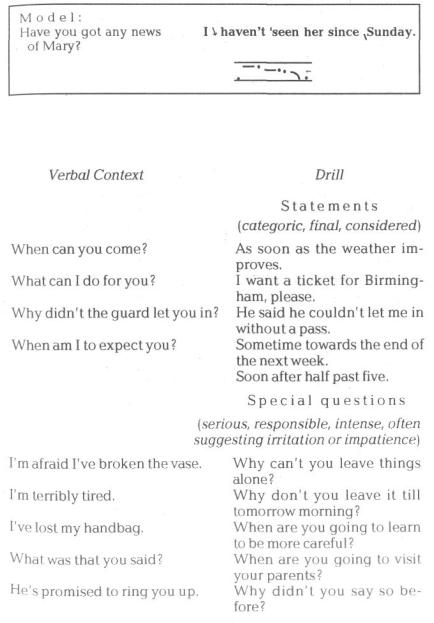
e. g. The exams are over at last. It's my birthday today. She refused my help.
Isn't it \wonderful!Many 'happy re\turns! What a strange 'thing to \do!
Exercises
(Low pre-head) + falling head + low fall (+ tail)
1. a)* Listen carefully to the following conversational situations. Concentrate your attention on the intonation of the replies:
204

b) Listen to the replies and repeat them in the intervals. Pronounce unstressed syllables in the pre-head as low as possible. Make the stressed syllables of the head carry the pitch lower. Do not forget to blend the words together. Make your voice fall on the last stressed syllable, c) Listen to the verbal context and reply in the interval.
(Low pre-head) + stepping head + low fall (+ tail)
The stepping head makes the utterance more weighty.
2. a)* Listen carefully to the following conversational situations. Concentrate your attention on the intonation of the reply:
205
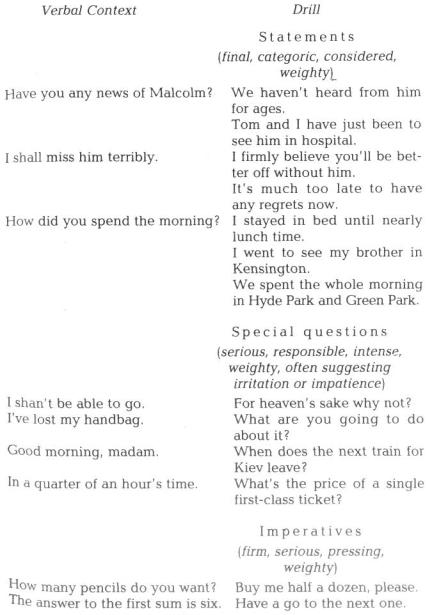
206

b) Listen to the replies and repeat them in the intervals. Pronounce unstressed syllables in the pre-head as low as possible. Make the stressed syllables of the head carry the pitch lower. Observe the same level of stressed and the following unstressed syllables of the head. Do not forget to blend the words together. Then make your voice fall on the last stressed syllable. c) Listen to the verbal context and reply in the interval.
(Low pre-head) + high level head + low fall (+ tail)
When the syllables of the head are pronounced on the high level pitch the head is called the High Level.
3. a)* Listen carefully to the following conversational situations. Concentrate your attention on the intonation of the replies:
207
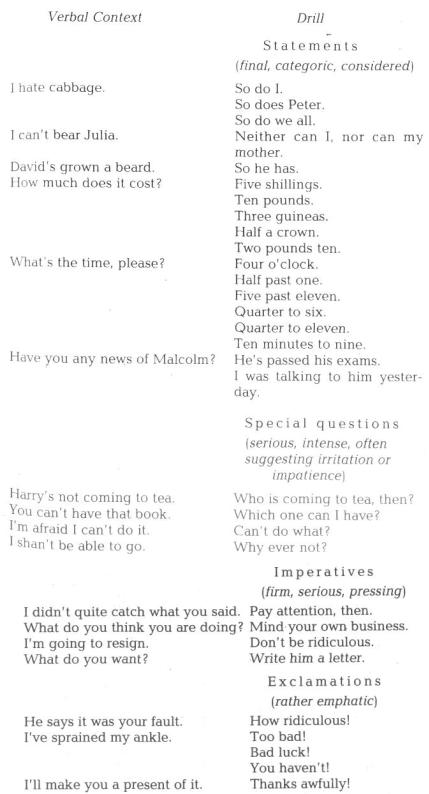
b) Listen to the replies and repeat them in the intervals. Observe high level tone of the head. Do not forget to blend the words together. Make your voice fall on the last stressed syllable. c) Listen to the verbal context and reply in the interval.
4.In order to fix Intonation Pattern II in your mind, ear and speech habits, repeat all the replies yourself until they sound perfectly natural to you. See that your Russian pronunciation habits do not interfere.
5.Listen to a fellow-student reading the replies. Tell him what his errors in intonation are.
6.Listen to your teacher reading the verbal context below. Reply by using one of the drill sentences. Pronounce it with Intonation Pattern II. Say what attitude you mean to render:
208
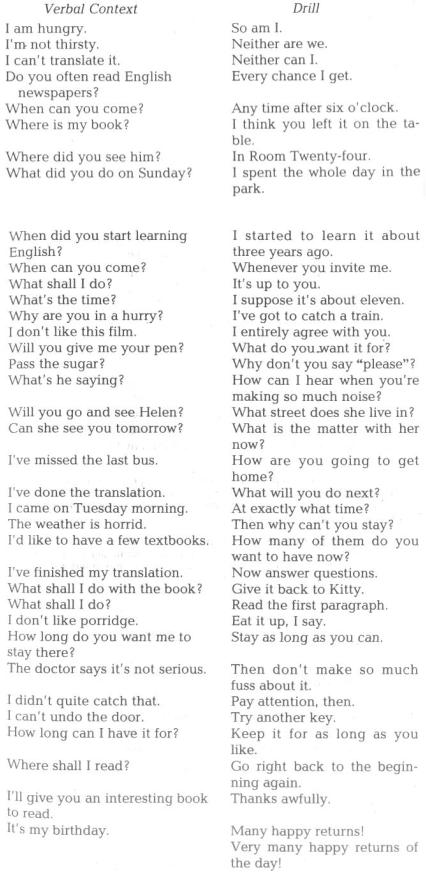
209
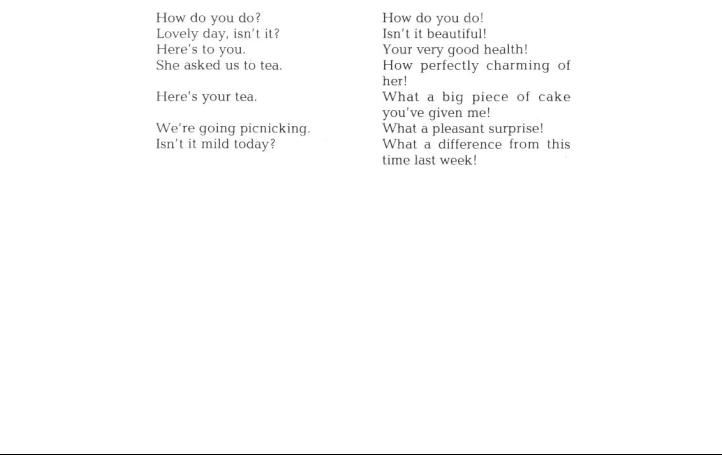
7. Your teacher will suggest a verbal context. You, in your turn, reply to it using Intonation Pattern II. The drill will continue until every student has participated. Keep the exercise moving on rapidly. Keep the attitude in mind.
Reference material for the teacher:
1. What's your name? 2. How old are you? 3. When is your birthday? 4. How many brothers have you? 5. How many sisters have you? 6. Where do you live? 7. Where do you come from? 8. Where do you study? 9. My pronunciation is not good. 10. When can you do it? 11. What do you think of the book? 12. I'd like to see you tomorrow. 13. How much have you paid for it? 14. How long have you been there? 15. Where do you usually rest? 16. What have you bought for lunch? 17. My cousin is a doctor. 18. I don't know this young man. 19. I'm afraid I can't do it in time. 20. I'm afraid I don't understand you. 21. Where have you put your bag? 22. Why have you bought the French newspaper? 23. What will you wear? 24. My mother is in St.Petersburg now. 25. She is not in. 26. I don't find it easy. 27. What is there in front of the building?
8.**1 Listen to the dialogues. Mark the stresses and tunes. Practise and memorize them:
1 Material for exercises marked with two asterisks is borrowed from the book by J. D. O'Connor "A Course of English Pronunciation". L., 1954.
a)"What's your name?" "My name's John." "How old are you?" "I'm thirty-five."
"When1 s your birthday?"
"It's on the tenth of December." "How many brothers have you ? " "I haven't any brothers at all." "How many sisters have you ? " "Just one."
b)A: Stand up. What have you done ?
B: I've stood up.
A:Pick up you pencil. What have you done?
B:I've picked up my pencil.
A:Give it to me. What have you done?
B:I've given it to you.
A:Sit down again. What have you done?
B:I've sat down again.
c)A: Look at this picture.
: How beautiful!
A:Now look at this book.
B:What a very big one!
A:Look at the sun.
B:Isn't it bright!
A:Look at me.
B:Oh dear!
210
